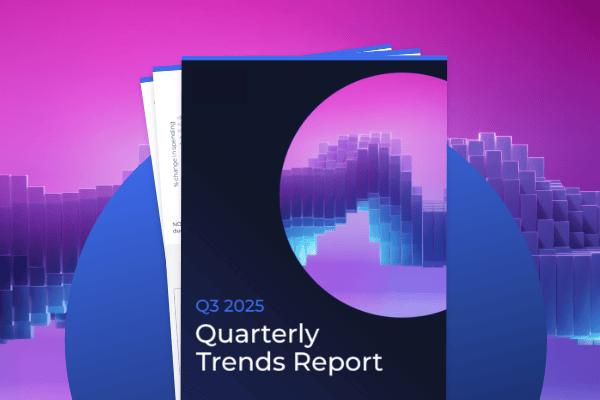Summary
To build a GenAI-ready marketing team, leaders must address adoption barriers and focus on three core skills: crafting effective prompts, interpreting AI insights within strategic context, and defining clear usage boundaries. These foundational abilities not only accelerate practical use but also help teams build confidence, consistency, and trust as they integrate GenAI into daily workflows.
Last updated: November 11, 2025
The impact of GenAI has been seismic for most industries. Think about it: You’re running a marketing team—it may be two people or 200. And they’re all looking to you to figure out what to do, how to do it, and how to make it feel manageable. The pressure to chart the path forward is real, and there’s rarely time to step back and build a plan.
You probably have a few early adopters who’ve been quietly using GenAI tools for a while now. But adoption is scattered. Some team members haven’t touched it. Others are trying, but inconsistently. You know GenAI is important. But knowing it’s important and knowing what to do next are two different things.
To make it harder, the landscape keeps shifting. Public tools like ChatGPT and Gemini are moving fast. Features that felt critical six months ago might already be outdated. And in the background, the tools your team already uses—analytics, creative, campaign management—are embedding GenAI whether you’re ready or not.
So how do you get your team ready for something that keeps changing?
The only real way is to use it. Like reps at the gym, GenAI only starts to click once you’ve practiced, tested, and pushed through a few bad sets. But most teams won’t get there on their own. They need structure. They need a starting point.
That’s where foundational skills come in. These three capabilities won’t solve everything, but they’ll give your team enough fluency to stop dabbling and start moving with confidence. And the good news: they’re learnable. No PhD required—just consistent use, honest feedback, and room to build.
Micro-answer: Prompts, insight literacy, guardrails.
What is the GenAI adoption gap—and what’s really holding teams back?
Many teams are experimenting without scaling.
Most roadblocks are process and trust—not tools.
Closing the gap starts with one vetted use case.
Recently, the Interactive Advertising Bureau released the report, State of Data 2025: The Now, the Near, and the Next Evolution of AI for Media Campaigns. One of the standout findings? While marketers are optimistic about AI’s potential, very few feel confident using it effectively today. As the report puts it: “Marketers see the promise of AI, but they’re still overwhelmed by the pace of change, the pressure to deliver, and the lack of shared guidance on how to move forward.”
If that sounds familiar, you’re not alone. These are the five top GenAI adoption blockers cited from that report via a survey of marketers. Don’t treat them like checkboxes—each one requires real change.
Complexity of setup/maintenance (Difficulty: 4/5)
Most tools don’t fail in implementation—they fail in week three. It’s not because they’re broken. It’s because no one built time into the process to rewire the surrounding systems. The initial rollout is the easy part—it’s the follow-through that breaks.
Try this: Pick one use case. Nail it. Then use what you learned to update internal playbooks, surface pain points, and ease others into it. Don’t scale what you haven’t tested. The fewer dependencies you start with, the faster you’ll see signal.
Data security risks (Difficulty: 5/5)
If people don’t trust the system, they won’t use it. And if legal doesn’t trust the system, they’ll block it. That’s not a warning. That’s just how it goes. A single misstep here can shut down momentum for months.
Try this: Bring legal and IT into the conversation early. Not as gatekeepers—but as partners. Work together to define the red lines and find the right tools with real controls, not just sales decks. Start drafting your red/green usage zones before you even choose a platform. Leaders should formalize change management and risk practices; Stanford’s AI Index 2025 documents rapid enterprise usage growth alongside rising incident risks, underscoring the need for disciplined guardrails.
Lack of AI knowledge (Difficulty: 3/5)
Most marketers weren’t trained on how to work with GenAI. They’re figuring it out as they go. And when there’s no shared understanding, there’s no consistency—only a lot of screenshots and trial runs. Most of the real friction comes from not knowing what “good” looks like.
Try this: Make this part of onboarding. Create a shared prompt library. Hold 30-minute team sessions to unpack what worked and what didn’t. Start normalizing the work of learning. Include examples that didn’t work, too—that’s where most of the growth happens.
Concerns about AI accuracy/transparency (Difficulty: 3/5)
Yes, it’ll be wrong sometimes. And yes, someone will forget to double-check. The goal isn’t perfection—it’s process. Blind trust is a bigger risk than AI itself.
Try this: Treat every output like a first draft. Add review steps. Build prompts that show their work—ask the AI to cite or explain why it made a decision. Transparency won’t slow you down. Lack of it will. Create a shared checklist of what always gets validated.
Data quality or accessibility issues (Difficulty: 4/5)
You know this one. Garbage in, garbage out. But with GenAI, even okay data can sound confident. And that’s where things get dangerous. Misleading outputs feel plausible until they’re in-market.
Try this: Focus less on perfection and more on usability. Create thresholds for what’s “good enough” to use. And make data access everyone’s job. Treat data like a product, not just a pipeline. If your team needs embedded, workflow-level support (not another standalone tool), explore Skai’s omnichannel marketing platform for cross-channel activation and measurement.
What are the 3 foundational GenAI skills every marketing team needs?
Prompts, interpretation, and responsibility drive impact.
Train repeatable prompts, teach insight literacy, and codify guardrails.
These shared skills convert dabbling into durable value.
Evidence continues to mount that structured adoption wins; Harvard Business Review highlights that systematic practices—clear KPIs, repeatable workflows, and role-specific guidance—separate pilots from scaled outcomes.
To operationalize AI where marketers already work, anchor enablement to Skai’s Celeste AI for prompt libraries, insight surfacing, and governed execution.
If you have early adopters on your team, they’re probably already experimenting. But for everyone else, that leap can still feel uncomfortable. And it’s hard to build muscle when you’re not sure where to start. That’s where these three skills come in.
They’re not merely tactical—they’re confidence builders. When lagging adopters start seeing small wins in real workflows, momentum follows. These skills create shared language, shared expectations, and a smoother ramp for everyone.
We’ve seen these show up again and again in GenAI success stories. They’re not flashy, but they’re powerful. And they’ll give your team the fluency it needs to stop dabbling and start using GenAI with intent.
Skill 1: Writing prompts that drive meaningful outputs
Prompting isn’t a trick. It’s not about phrasing things just right to “unlock” the model. It’s about being clear on what you want and how the system can help. Prompting is fast becoming a core workplace skill—like writing a good brief.
Good prompts aren’t long. They’re structured. Context. Role. Task. Constraints. The teams that get this? They write it once and reuse it. Everyone else is starting from scratch every time. Reusability is a clear marker of maturity.
If you want to level up fast, A Marketer’s Guide to Prompt Engineering breaks down core prompt types by function. Use it to stop guessing—and start getting more from the same inputs. You’ll save more time from repeatability than from novelty.
But beyond that, precision matters. Generic prompts = generic results. This post breaks down how to adapt GenAI by channel—because what works for a retail media brief isn’t what works for a paid search test. The more granular your prompts, the more useful your outputs. Treat your prompts like assets—they’re worth refining.
From theory to practice: what to try
- Identify three common use cases (e.g., campaign summaries, brainstorm kickoffs, competitive analysis) and write reusable prompts for each
- Set up a shared prompt doc that includes “good,” “better,” and “needs work” examples from within the team
- Encourage people to add constraints like tone, format, or time period—these sharpen the result fast
- Try writing prompts backward: Start with the output you want, then build the ask that would generate it
- Host a “prompt challenge” where team members compete to get the best GenAI output from the same brief
Skill 2: Interpreting AI insights with strategic context
GenAI can show you patterns. But it won’t tell you which ones to act on. That’s still on you. Interpretation is where human judgment earns its keep.
If a tool says “this campaign underperformed,” what does that mean? Compared to what? Because of what? And does it matter? You still need someone in the room who can make the call. The wrong call can still come from the right data.
It helps to set up rules for what counts as signal. Have a POV on what kinds of insights are worth acting on—and which ones get logged and left behind. Otherwise, you’re swimming in summaries. Add thresholds for what triggers a deeper look.
And don’t forget how insights get communicated. If GenAI is generating reports or summaries, someone needs to tailor that messaging to internal stakeholders. A solid insight, poorly framed, can get ignored. Strategic context isn’t simply about what the AI finds—it’s about how your team uses it to drive real decisions.
From theory to practice: what to try
- Build a framework: When the AI shows X, we ask Y—so the response isn’t blind action
- Keep a log of GenAI insights that led to real business impact (and ones that didn’t)
- Assign someone to “translate” GenAI outputs for specific roles—insights land better when they’re tailored
- Define what “interesting but not useful” looks like, so the team isn’t overwhelmed by low-impact outputs
- Pair GenAI-generated insights with campaign post-mortems to surface new patterns and nuance
Skill 3: Clarity on usage, risk, and responsibility
This part doesn’t get talked about enough. But if you don’t know where the guardrails are, you’ll eventually crash into them. You don’t need a policy doc—you need awareness. And not having this clarity can paralyze your team because they’re not sure if they should even be using GenAI for a certain task.
Teams move faster when they know what’s in bounds. That means having basic fluency in where GenAI can be used, where human review is required, and what kinds of use cases are too risky to bother with. Consistency builds trust across departments.
One of the most practical parts of this skill? Knowing when GenAI is making things up. Hallucinations aren’t rare—they’re baked into how these models work. Spotting them quickly (and knowing what kinds of tasks are most prone to them) is essential. It’s not exclusively about accuracy. It’s about credibility. If your team can’t recognize when the AI is confidently wrong, the risk isn’t just wasted time—it’s real damage to trust, internally and externally.
From theory to practice: what to try
- Create a “Yes / Ask / No” matrix for GenAI use cases across content, media, and reporting
- Add GenAI redlines to existing creative and brand guidelines so teams don’t have to guess
- Role-play borderline use cases as a team: would you escalate this one or run with it? Why?
- Bring legal in for a quarterly check-in on usage trends, not a one-time training
- Draft a one-pager for new hires: Here’s what’s okay to use GenAI for, here’s what’s not
Conclusion: Is the shift coming—or already here?
GenAI value appears when it’s embedded—not adjacent.
Make AI part of the daily motion—inside current tools and reviews.
Small, governed wins compound into durable capability.
There’s a difference between public GenAI tools and purpose-built ones. Public tools—ChatGPT, Gemini, Claude—are flexible and broad, but disconnected. They don’t know your workflows. They don’t understand your priorities. They’re useful, but they’re not integrated. The gap between novelty and impact often starts here.
Purpose-built tools are different: They live inside the platform. They’re designed for media planning, measurement, campaign optimization—whatever the day job actually looks like. And when they work well, they disappear into the flow.
If GenAI’s going to work for your team, it has to meet them where they are. Inside the tools they already use. Solving the problems they already face. Not in some separate window. Frictionless doesn’t mean fancy, it means embedded.
Teams that move fastest aren’t chasing the next new tool. They’re making GenAI part of their daily motion. And once that happens, there’s no going back.
Related Reading
- How Acosta Group Streamlined Reporting and Empowered Its Team with Celeste AI — Shows how AI-assisted insight retrieval cut reporting from hours to minutes, freeing teams for strategy.
- How Marshall Helped ZUP to Drive Revenue and Outmaneuver Competitors Using AI-Powered Insights — Demonstrates GenAI-driven keyword and audience insights improving CPCs and ROI.
- Wild Fi Lowers Cost per Acquisition by 55% with Skai’s Signal Enhancement — Illustrates how integrating “true north” data with AI improves conversion efficiency.
How do we know if our marketing team is GenAI-ready?
Standardize a shared prompt library, require examples of “good/better/needs-work,” and version templates so improvements compound across teams.
Pair prompts with review guardrails, including privacy/brand checks and KPI thresholds, so outputs translate into decisions—not just drafts.
How should we structure “insight literacy” training?
Teach KPI-anchored interpretation, comparing AI outputs to baselines, confidence, and business context before activation.
Document red/green/ask zones, clarifying when teams can ship, when review is required, and when use is prohibited.
Where does GenAI sit alongside traditional automation?
Use rules for repeatable steps and GenAI for variable inputs, summarization, and cross-signal reasoning.
Integrate both inside existing workflows so planning, activation, and reporting benefit without creating a separate tool island.
Glossary
Prompt Engineering — A structured way to request outputs from GenAI (context, role, task, constraints) that turns ad-hoc questions into reusable, high-quality instructions for repeatable team results.
Insight Interpretation — The practice of translating model findings into decisions by comparing to benchmarks, business context, and KPI thresholds.
Guardrails (Red/Green/Ask Zones) — Operational rules that define safe, review-required, and prohibited GenAI use cases across data, creative, and reporting.
Hallucination — A confident but incorrect AI output; managed via source-backed prompts, validation steps, and reviewer sign-off.
Signal Enhancement — Integrating high-quality first-/offline data to improve optimization and measurement fidelity across channels.
AI Dayparting — Algorithmic intraday bid/budget adjustments that align spend to high-value windows; complements GenAI planning and reporting.
Portfolio Optimization — Cross-campaign budget and bid governance that compounds small gains at scale—critical when pairing AI recommendations with financial goals.







